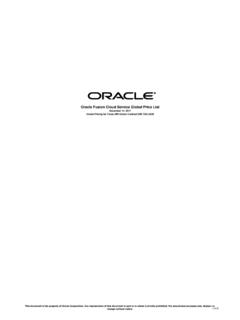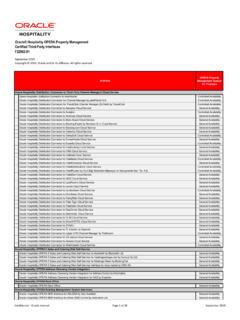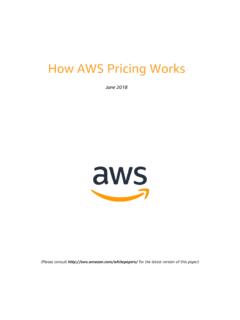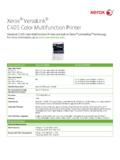Transcription of Oracle Cloud Infrastructure Security
1 Oracle Cloud Infrastructure Security Oracle WHITE PAPER | APRIL 2019 2 | Oracle Cloud Infrastructure Security Disclaimer The following is intended to outline our general product direction. It is intended for information purposes only, and may not be incorporated into any contract. It is not a commitment to deliver any material, code, or functionality, and should not be relied upon in making purchasing decisions. The development, release, and timing of any features or functionality described for Oracle s products remains at the sole discretion of Oracle . Revision History The following revisions have been made to this white paper since its initial publication: Date Revision April 2, 2019 Added descriptions of new Security services . November 12, 2018 Added descriptions of new Security features and services . August 13, 2018 Added descriptions of new Security features and compliance capabilities, and added a new section about high-level Security guidelines for Security configuration.
2 You can find the most recent versions of the Oracle Cloud Infrastructure white papers at 3 | Oracle Cloud Infrastructure Security Table of Contents Oracle Cloud Infrastructure : Next-Generation Enterprise Cloud 5 Security Objectives 5 Shared Security Model 6 Security services and Features 8 Regions, Availability Domains, and Fault Domains 8 Identity and Access Management (IAM) Service 9 Key Management 13 Audit Service 15 Oracle CASB Monitoring 15 Compute Service 16 Networking Service 17 Storage services 20 Data Transfer Service 22 Database Service 22 Load Balancing Service 23 Managed Domain Name System Service 23 Web Application Firewall Service 24 Email Delivery Service 24 Container Engine for Kubernetes 25 Registry 26 High-Level Guidelines for Security Configuration 26 Infrastructure Security 28 Security Culture 29 Security Design and Controls 30 Secure Software Development 31 4 | Oracle Cloud Infrastructure Security Personnel Security 32 Physical Security 32 Security Operations 34 Customer Data Protection 34 Data Rights and Ownership 34 Data Privacy 34 Law Enforcement Requests 35 Compliance 35 Conclusion 36 5 | Oracle Cloud Infrastructure Security Oracle Cloud Infrastructure .
3 Next-Generation Enterprise Cloud Enterprises need scalable hybrid Cloud solutions that meet all their Security , data protection, and compliance requirements. To meet this need, Oracle developed Oracle Cloud Infrastructure , which offers customers a virtual data center in the Cloud that allows enterprises to have complete control with unmatched Security . Oracle Cloud Infrastructure is a Cloud platform designed and architected to support enterprise applications and customers. The platform provides high-performance, secure, and highly available services that scale elastically to handle a wide variety of enterprise workloads. Oracle Cloud Infrastructure offers a variety of Cloud services including bare metal compute, virtual machines (VMs), software-defined virtual Cloud networks (VCNs), high-performance managed Oracle databases, remote block storage, object storage, audit, identity and access management, managed load balancing, DNS, and other edge services .
4 Oracle Cloud Infrastructure was designed and built to run mission-critical, enterprise workloads while also supporting modern Cloud -native workloads. Primary considerations for enterprise customers who want to leverage a public Cloud are data Security and the effort involved in migrating existing applications. Given the constraints of traditional public clouds, enterprises normally migrate noncritical applications to the Cloud and continue to restrict mission-critical production applications and data to their on-premises data centers. Oracle built Oracle Cloud Infrastructure to enable enterprises to maximize the number of mission-critical workloads that they can migrate to the Cloud while continuing to maintain a strong Security posture and reduce the overhead of building and operating data-center Infrastructure . With Oracle Cloud Infrastructure , enterprise customers get the same control and transparency into their workloads as they have on-premises.
5 For customers who need a fully isolated and controlled environment, Oracle Cloud Infrastructure offers bare metal instances that are completely managed by the customer without any Oracle software running on the instance. This offering is a result of significant innovation by Oracle Cloud Infrastructure and provides greater control, transparency, and software flexibility alongside traditional benefits of Cloud , such as automated provisioning and elasticity of Infrastructure . Security Objectives Oracle s mission is to build Cloud Infrastructure and platform services where Oracle customers have effective and manageable Security to run their mission-critical workloads and store their data with confidence. 6 | Oracle Cloud Infrastructure Security Oracle Cloud Infrastructure s Security approach is based on seven core pillars. Each pillar has multiple solutions designed to maximize the Security and compliance of the platform.
6 Customer isolation: Allow customers to deploy their application and data assets in an environment that commits full isolation from other tenants and Oracle s staff. Data encryption: Protect customer data at-rest and in-transit in a way that allows customers to meet their Security and compliance requirements with respect to cryptographic algorithms and key management. Security controls: Offer customers effective and easy-to-use application, platform, and network Security solutions that allow them to protect their workloads, have a secure application delivery using a global edge network, constrain access to their services , and segregate operational responsibilities to reduce the risk associated with malicious and accidental user actions. Visibility: Offer customers comprehensive log data and Security analytics that they can use to audit and monitor actions on their resources, allowing them to meet their audit requirements and reduce Security and operational risk.
7 Secure hybrid Cloud : Enable customers to use their existing Security assets, such as user accounts and policies, as well as third-party Security solutions when accessing their Cloud resources and securing their data and application assets in the Cloud . High availability: Offer fault-independent data centers that enable high availability scale-out architectures and are resilient against network attacks, ensuring constant uptime in the face of disaster and Security attack. Verifiably secure Infrastructure : Follow rigorous processes and use effective Security controls in all phases of Cloud service development and operation. Demonstrate adherence to Oracle s strict Security standards through third-party audits, certifications, and attestations. Help customers demonstrate compliance readiness to internal Security and compliance teams, their customers, auditors, and regulators. Additionally, Oracle employs some of the world s foremost Security experts in information, database, application, Infrastructure , and network Security .
8 By using Oracle Cloud Infrastructure , our customers directly benefit from Oracle s deep expertise and continuous investments in Security . Shared Security Model Oracle Cloud Infrastructure offers best-in-class Security technology and operational processes to secure its enterprise Cloud services . However, for customers to securely run their workloads in Oracle Cloud Infrastructure , they must be aware of their Security and compliance responsibilities. By design, Oracle provides Security of Cloud Infrastructure and operations ( Cloud operator access controls, Infrastructure Security patching, and so on), and customers are responsible for securely 7 | Oracle Cloud Infrastructure Security configuring their Cloud resources. Security in the Cloud is a shared responsibility between the customer and Oracle . In a shared, multi-tenant compute environment, Oracle is responsible for the Security of the underlying Cloud Infrastructure (such as data-center facilities, and hardware and software systems) and customers are responsible for securing their workloads and configuring their services (such as compute, network, storage, and database) securely.
9 In a fully isolated, single-tenant, bare-metal server with no Oracle software on it, the customers responsibility increases as they bring the entire software stack (operating systems and above) on which they deploy their applications. In this environment, customers are responsible for securing their workloads, and configuring their services (compute, network, storage, database) securely, and ensuring that the software components that they run on the bare metal servers are configured, deployed, and managed securely. More specifically, customer and Oracle responsibilities can be divided into the following areas: Identity and access management (IAM): As with all Oracle Cloud services , customers should protect their Cloud access credentials and set up individual user accounts. Customers are responsible for managing and reviewing access for their own employee accounts and for all activities that occur under their tenancy.
10 Oracle is responsible for providing effective IAM services such as identity management, authentication, authorization, and auditing. Workload Security : Customers are responsible for protecting and securing the operating system and application layers of their compute instances from attacks and compromises. This protection includes patching applications and operating systems, operating system configuration, and protection against malware and network attacks. Oracle is responsible for providing secure images that are hardened and have the latest patches. Also, Oracle makes it simple for customers to bring the same third-party Security solutions that they use today. Data classification and compliance: Customers are responsible for correctly classifying and labeling their data and meeting any compliance obligations. Also, customers are responsible for auditing their solutions to ensure that they meet their compliance obligations.




